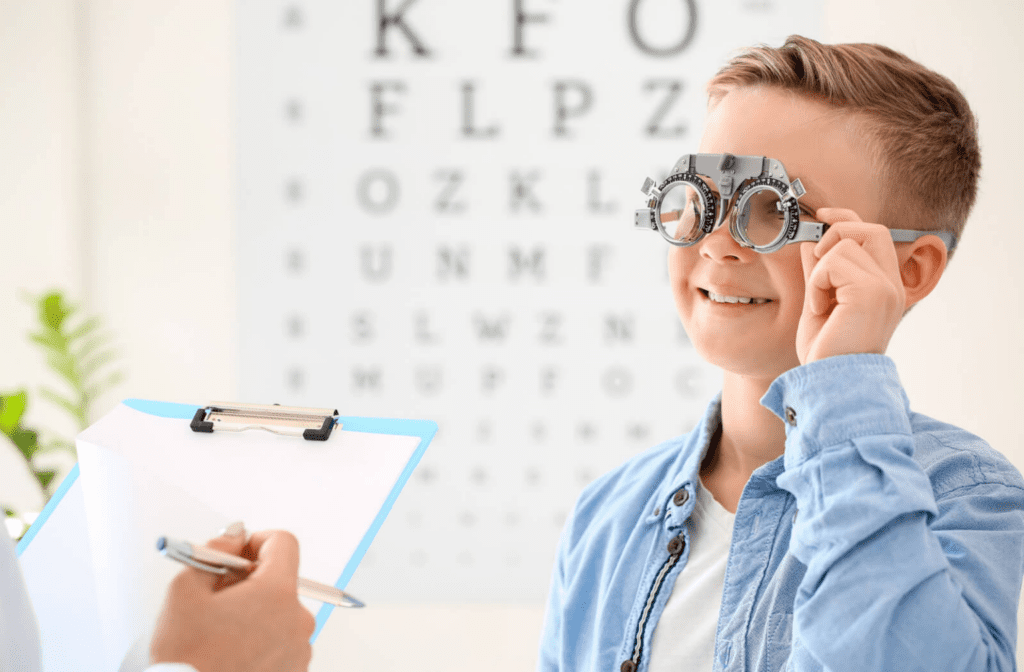Table of Contents

Introduction
There’s a lot you can do for your child’s vision that will impact them all the way through adulthood. Eye exams may give you an early insight into potential issues, such as myopia. Researchers estimate that by 2050 as much as 50% of the world will have this progressive condition.
All around the world, eye care professionals are developing new technologies to slow myopia’s progression in children. Advanced lenses such as MiYOSMART and Stellest work by cueing the eye not to elongate using natural mechanisms. While spectacle options such as MiYOSMART and Stellest aren’t available in the U.S. yet, contact lenses such as MiSight, are. We are excited to stay updated with the latest research and availability of these effective treatment options.
What Is Myopia?
To understand how lenses can manage myopia, it’s essential first to understand what myopia, or nearsightedness, is.
Myopia is a type of refractive error that occurs when the eyeball grows too long or the cornea (the clear front dome of the eye) is too curved. It’s called a refractive error because when light enters your eye, it gets refracted (bent) by the cornea and lens.
In an eye without refractive errors, the light rays can focus directly on the retina at the back of the eye, which sends information to the brain and gives us an image. However, the light doesn’t focus on the retina correctly in people with myopia. This results in faraway objects being blurry while nearby objects stay clear.
Experts aren’t entirely sure what causes myopia. Evidence seems to show genetics are a factor, and you may be more likely to develop myopia if your parents are nearsighted. However, its actual development is also linked to a child’s environment.
Some research has shown excessive near work such as screen time through smartphone use may increase the risk of myopia by 30%, and combined with high levels of computer use, the risk increases to around 80%.
Symptoms of Myopia
It can be hard to notice signs of myopia in children, as they tend not to have the words to explain what’s happening to them. This is why eye exams are essential. However, there are signs you can watch for that may indicate your child has a vision problem:
- Frequent squinting, covering one eye, or tilting head to one side
- Headaches
- Excessive eye rubbing/blinking
- Holding books or papers close to face to read or avoiding reading in general
- Complaining about discomfort or fatigue
- Lack of focus when reading
Diagnosing myopia early and beginning a management plan may slow its progression and keep it from worsening into high myopia. High myopia is generally considered to be a prescription of -6.00 diopters or greater and can increase your risk of severe eye conditions such as:
- Glaucoma
- Cataracts
- Retinal detachment
- Myopic macular degeneration

MiYOSMART Lenses
An optometrist can typically correct myopia with standard single-vision eyeglasses or contact lenses. While these kinds of lenses are great for providing clear vision, they won’t slow myopia’s progression. An adult whose myopia has stabilized can manage just fine with a good pair of single-lens contacts, but children can benefit from measures to slow myopia progression.
Developed in collaboration with The Hong Kong Polytechnic University, MiYOSMART lenses utilize DIMS Technology to slow myopia’s progression in school-aged children. DIMS stands for Defocus Incorporated Multiple Segments and refers to a zone of evenly placed “islands” of defocus.
While the lens’s center offers full myopic correction, these islands are purposefully made to have a weaker prescription. By simultaneously seeing a focused and defocused image, the lens triggers a natural mechanism that tells your child’s eye to stop elongating.
A 2-year clinical trial showed that MiYOSMART lenses could slow myopia progression in children by around 60% compared to single-vision lenses!
Essilor Stellest Lenses
Essilor Stellest lenses follow the concept of zones of focus and defocus while bringing new technology to the forefront. Essilor Stellest lenses use Highly Aspherical Lenslet Target (HALT) technology.
The center of the lens still corrects myopia as you would expect, but it’s surrounded by 11 rings of 1021 tiny aspherical lenslet. The spaces between these lenslet rings are also single-vision lenses, allowing you to see clearly.
Essilor Stellest’s “spread” of unfocused light signals the brain to slow eye growth significantly. For children who wore Stellest lenses full-time, researchers noted the final prescription was almost 1.00 diopters less when compared to children who wore single-vision lenses.
MiSight Contact Lenses
MiSight lenses use focus and defocus zones shaped like a bullseye to give the eye contrasting signals. The center corrects light so it falls on the retina, while the outer rings defocus peripheral light and make it fall in front of the retina.
MiSight is the first myopia management lens for children approved by the FDA. By focusing peripheral light in front of the retina, multifocal contact lenses naturally signal your child’s eyes to stop growing and may slow myopia by around 43%.
Myopia Management Solutions
While myopia control spectacle lenses can be a great option for slowing the progression of myopia, it’s important to note that compliance of wear time, having properly fitted frames and lenses by your eye doctor, and scheduling regular comprehensive follow-up exams are essential to the success of this myopia management solution. You can read more in this article 戴了离焦框架镜,为何近视还是控制不理想?眼科医生杨羿
Golden Vision has a variety of myopia management solutions, and multifocal contact lenses are only one of the effective methods we offer. So if your child has myopia, don’t let it go on longer than it has to. Book an appointment with us and see what passion and experience in myopia management can do!

